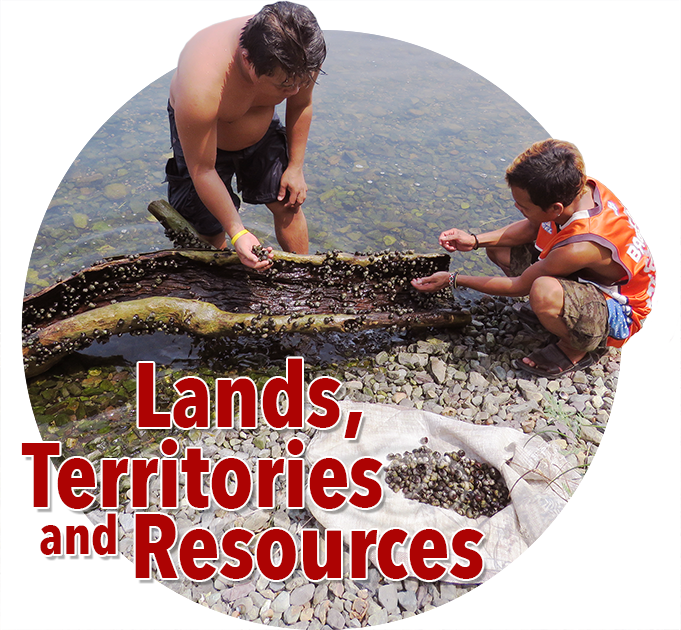|
Status and trends on Land Use and Land tenure
- Land area of the customary territory as perceived by the IP community ; location, boundaries elevation, slopes, terrain, land formation)
- Land areas according to customary land uses; resources and biodiversity found under each land use
- Land areas according to customary tenural arrangement [land of the commons, land of the clan, shared lands, private lands, etc)
- Forms of tenure according to customary ownership or stewardship
- Percentage / number of households having access or utilizing land of the commons; number of households having clan owned, private lands
- Land, and resources owned by the community, but under the control of or claimed by the state or corporations
- Land areas according to spiritual/and sacred sites
- Land areas according to state classification; resources found within; how does this relate with customary land uses
- Forms of tenure under statutory laws
- Land areas recognized by state as customary lands, instruments recognizing land tenure of IPs, no of HHs/IPs given formal recognition for access/ or ownership
- Land and resources owned by the state but used by community [as land of the commons, shared or private]
- Land areas prone to disasters
Historical account/data on LTR[1]/ forms of tenure under customary ownership
- state laws that have affected the traditionally owned/used lands/ territories and resources
- land used/converted to other uses (privatized, used for extractive industries/plantations, etc.)
- existing areas under conflict and historical account of said conflicts
|
Increase or decrease in land areas:
- of customary territory; 2) according to land use;
- according to customary land tenure
- with customary land tenure, no. of people benefitting
- with customary land tenure recognized by state and those not recognized by state
- areas of conflicts
- areas under control of state or corporations
- areas claimed by state but can be used by IP’s
- Percentage change of IPs/HHs who have access to land tenure; forest use and other important resource
- Laws enacted affecting traditional land-use and land tenure and their effects
- No. of communities or % of population affected
- Lands converted to different land use
- Statutory and /or IP intervention on disaster prone areas
- increase or decrease of land areas prone to disaster
|
Territory map showing different layers:
scope of the territory; land areas according to customary land uses; land areas according to land tenural arrangement, and all other data that can be shown in maps
Matrix showing :
- Territory land areas dis-aggregated according to
- Ownership/control
- Land uses with corresponding areas and resources
- Areas of conflicts
Historical changes in territory brought about by major events (i.e disasters, land use conversion, change in tenure) be mapped, may use matrix and needs narrative on causes of changes, effects and impacts, no of IP’s affected
Show in map:
- Within the customary territory, show land areas claimed by state and resources within; IP lands recognized by government, number of households or communities involved, others
- Show in map changes in land due to state laws on tenure and land use and or land classification, lands affected by what state laws
|
|
In relation to forest and water:
- FOREST Lands
- under customary control and owned by the commons
- managed and used by IP communities
- shared forest land
- owned by state
- owned by state but being used and managed by the IP community
- Laws/policies recognizing, promoting and protecting customary ways of accessing, managing and protecting the forest
WATER
- Customary recognition of rights over water (collectively owned/ private? shared?)
- Water resources under control of the state
- IPs’ perspective on water quality
|
Increase or decrease in
- Percentage of forest protected by state &/or IP’s
- Percentage /number of law passed/implemented recognizing the customary rights of people to their forest and its management
- Decrease/increase in no. of water sources, water volume, quality and portabilityof water for community use
- Incidences of water related violence and tensions
|
Map data and location of forest and water resources
- Lists and analysis of laws,policies, programames and strategies;
- Impacts , can be shown through case study
|
|
Biodiversity
- Biodiversity per unit area in forests
- list of endangered species in various ecosystems of the territories
- list /existence of invasive species
- list stock-take of indigenous medicine plant species
|
List of flora and fauna of different, uses and assessment on trends from historical information’s [assessment can be qualitative increasing, decreasing, threatened since when?
- Trends and changes in access to indigenous medicine
|
Use of seasonal/bio-cultural calendars
|

